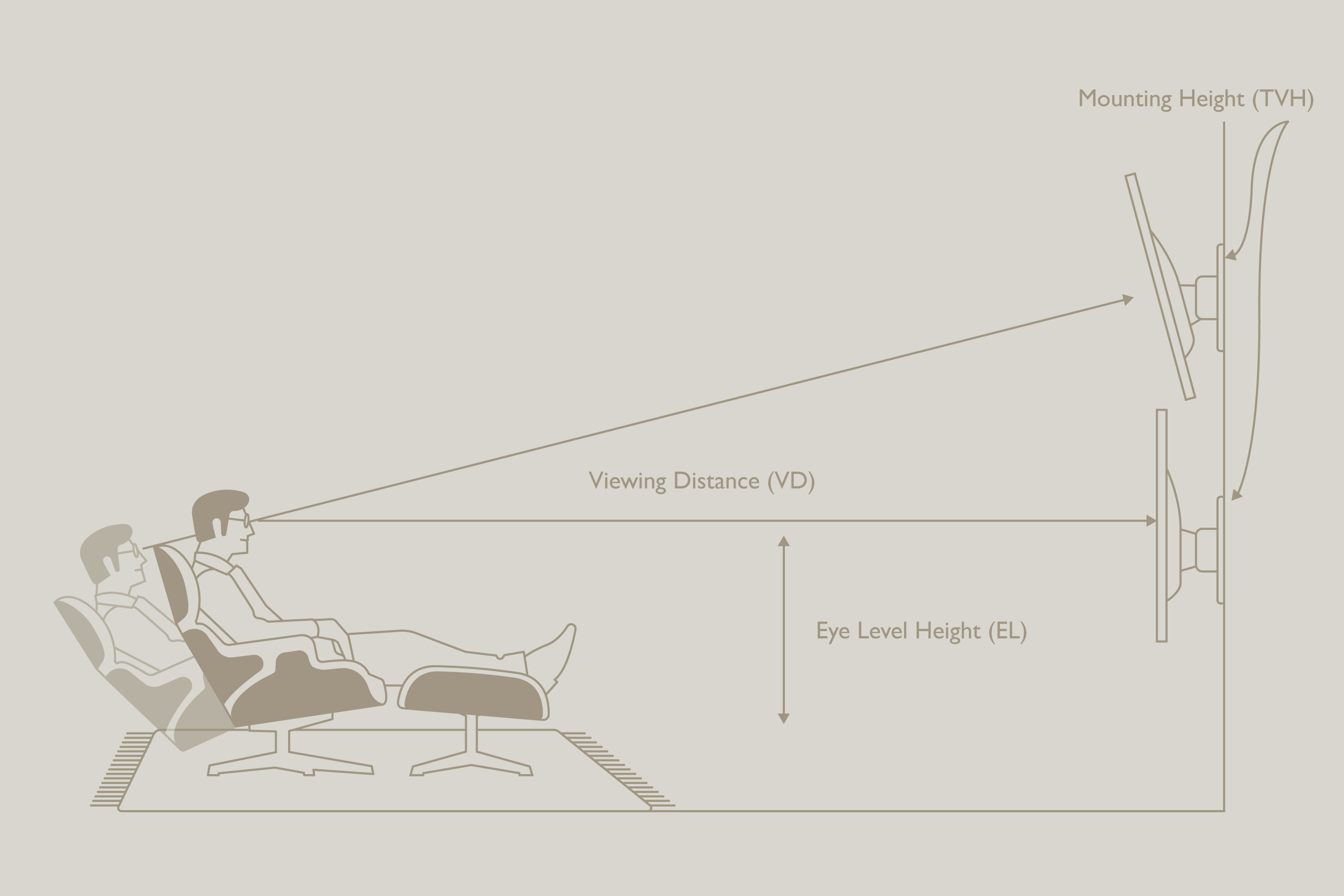When designing the home theatre of your dreams, the placement of your TV screen is one of the first things to consider. Even if you’re just adding a wall-mounted flat screen to your living room, getting the height and viewing angles right can make a world of difference.
Getting your screen set up for comfortable viewing can seem like a daunting task, but it’s actually fairly straightforward. All you’ll need to know is the size of your TV, how far away from it you’ll be sitting, and the viewing angle.
Getting your screen set up for comfortable viewing can seem like a daunting task, but it’s actually fairly straightforward. All you’ll need to know is the size of your TV, how far away from it you’ll be sitting, and the viewing angle.
Horizontal Viewing Angle
Even though our peripheral vision allows us to see a field-of-vision that is nearly 180° wide, it is not as easy to focus on images outside of a much smaller angle. Images right in front of you tend to become the main focus and action at the periphery of the screen can be missed. Your screen should be inside of that angle for as immersive an experience as possible.
The Society of Motion Picture and Television Engineers (SMPTE) sets that viewing angle at 30° based on an aspect ratio of 16:9, while the THX standard for the farthest seat in the centre of the theatre is a little wider at 36° (based on an aspect ratio of 2.39:1). The standard for home theatre is quickly becoming 2.39:1.
If sitting too close to very large TVs, portions of the screen will fall outside of the 36° angle, forcing your eyes to move more than necessary, which could lead to fatigue. On the other hand, as resolutions increase, so does your viewing angle. With a 4K display, you may even be able to stretch that angle out to over 50°. There really is no perfect answer to a viewing angle for every situation, but if you try to stay close to 36°, everyone in the room should be able to enjoy a great viewing experience.
Whilst that covers the horizontal placement of the screen, it is also crucial to consider the vertical placement.
The Society of Motion Picture and Television Engineers (SMPTE) sets that viewing angle at 30° based on an aspect ratio of 16:9, while the THX standard for the farthest seat in the centre of the theatre is a little wider at 36° (based on an aspect ratio of 2.39:1). The standard for home theatre is quickly becoming 2.39:1.
If sitting too close to very large TVs, portions of the screen will fall outside of the 36° angle, forcing your eyes to move more than necessary, which could lead to fatigue. On the other hand, as resolutions increase, so does your viewing angle. With a 4K display, you may even be able to stretch that angle out to over 50°. There really is no perfect answer to a viewing angle for every situation, but if you try to stay close to 36°, everyone in the room should be able to enjoy a great viewing experience.
Whilst that covers the horizontal placement of the screen, it is also crucial to consider the vertical placement.
Calculate Viewing Distance
Viewing Distance (VD) is the distance between where a viewer sits and the wall the screen is to mounted on.
VD = TV diameter x 1.67
Viewing Distance for 42” TV: 42" x 1.67= 5.8 feet
Viewing Distance for 55” TV: 55" x 1.56 = 7.5 feet
Viewing Distance for 65” TV: 65" x 1.67 = 9 feet
Viewing Distance for 75” TV: 75" 1.67 = 10.5 feet
Viewing Distance for 42” TV: 42" x 1.67= 5.8 feet
Viewing Distance for 55” TV: 55" x 1.56 = 7.5 feet
Viewing Distance for 65” TV: 65" x 1.67 = 9 feet
Viewing Distance for 75” TV: 75" 1.67 = 10.5 feet
Calculate Eye Level Height
Measure the height from the floor to your eye level (EL) while sitting in your viewing seat. Note that if you will be reclining, the EL distance will be different than if you are sitting upright, so try to find your most comfortable viewing position for this measurement.
Calculate TV Mounting Height (TVH)
Next, calculate the mounting height to the television's centre point. Here a measured sitting height of 36” is used as an example.
EL+(VD*.22) = TVH
In our example for a 65” television: 36+(109*.22) = 59.98” (round up to 60”)
This sets the centre point mounting height of your 65” TV at 60” from the floor. If you have multiple rows with one or more rows set on a riser, take the average EL height and use that for your calculation.
This sets the centre point mounting height of your 65” TV at 60” from the floor. If you have multiple rows with one or more rows set on a riser, take the average EL height and use that for your calculation.
Be sure to follow manufacturer’s instructions exactly when installing your television bracket, then sit back, relax and immerse yourself in your home theatre experience.
Find My Retailer
Find out more about our LS Wireless Collection and book a demo at your nearest KEF retailer.
FIND MY RETAILER





